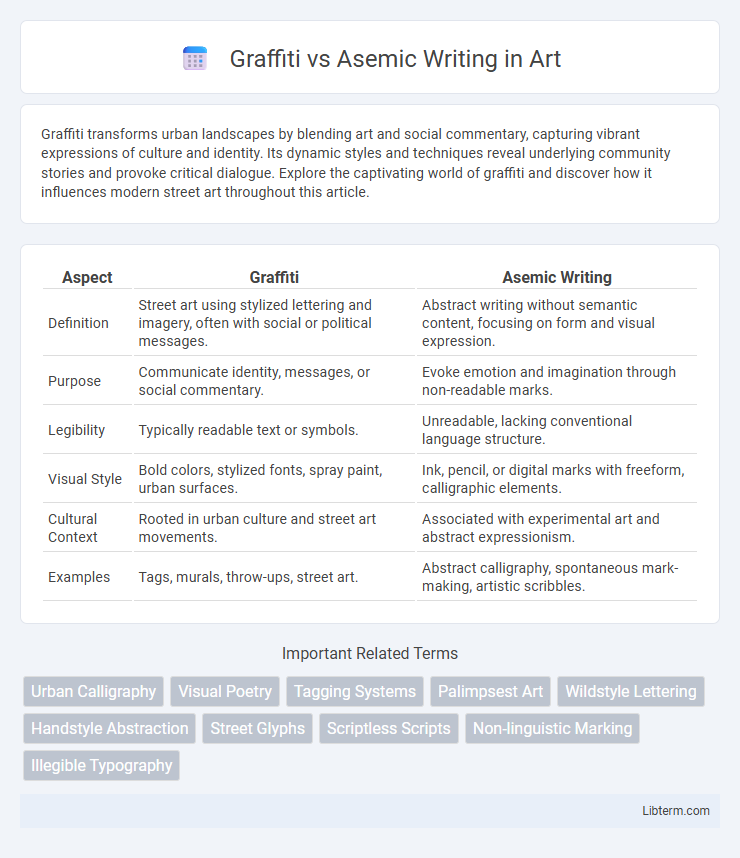Graffiti transforms urban landscapes by blending art and social commentary, capturing vibrant expressions of culture and identity. Its dynamic styles and techniques reveal underlying community stories and provoke critical dialogue. Explore the captivating world of graffiti and discover how it influences modern street art throughout this article.
Table of Comparison
| Aspect | Graffiti | Asemic Writing |
|---|---|---|
| Definition | Street art using stylized lettering and imagery, often with social or political messages. | Abstract writing without semantic content, focusing on form and visual expression. |
| Purpose | Communicate identity, messages, or social commentary. | Evoke emotion and imagination through non-readable marks. |
| Legibility | Typically readable text or symbols. | Unreadable, lacking conventional language structure. |
| Visual Style | Bold colors, stylized fonts, spray paint, urban surfaces. | Ink, pencil, or digital marks with freeform, calligraphic elements. |
| Cultural Context | Rooted in urban culture and street art movements. | Associated with experimental art and abstract expressionism. |
| Examples | Tags, murals, throw-ups, street art. | Abstract calligraphy, spontaneous mark-making, artistic scribbles. |
Introduction to Graffiti and Asemic Writing
Graffiti is a form of visual expression characterized by stylized letters, symbols, and images often created in public spaces to convey messages or showcase artistic skill. Asemic writing, in contrast, is a wordless, abstract form of writing that lacks semantic content, focusing instead on the visual aesthetics of mark-making without specific linguistic meaning. Both practices challenge traditional notions of language and communication, using visual elements to evoke emotion and interpretation beyond conventional text.
Origins and Historical Development
Graffiti originated in ancient civilizations such as Egypt and Rome, where public inscriptions and drawings expressed social, political, and personal messages. Asemic writing emerged in the 20th century as an abstract, wordless form of writing, emphasizing visual expression over semantic content, influenced by avant-garde art movements like Dada and Surrealism. Both art forms evolved as distinct modes of communication, with graffiti rooted in direct public engagement and asemic writing exploring the boundaries of written language and meaning.
Defining Graffiti: Expression and Identity
Graffiti serves as a powerful form of urban expression, often reflecting personal and cultural identity through bold visuals and stylized lettering. It claims public spaces as canvases where artists assert presence and communicate social or political messages. Distinct from traditional writing, graffiti embodies a visual language that intertwines art, rebellion, and self-expression in city environments.
Understanding Asemic Writing: Language Beyond Meaning
Asemic writing transcends conventional language by presenting marks and symbols that lack specific semantic content, differentiating it from graffiti, which often conveys clear messages or social commentary. This form of art explores abstract visual language, inviting viewers to interpret it without predetermined meaning, emphasizing form, texture, and rhythm over literal interpretation. Understanding asemic writing requires recognizing its role as a bridge between visual art and language, challenging traditional notions of communication by embracing ambiguity and open-ended expression.
Visual Aesthetics: Style and Technique Comparison
Graffiti employs bold colors, dynamic lines, and recognizable letterforms to create visually striking urban art, often emphasizing legibility and message clarity through spray paint or markers. Asemic writing, by contrast, focuses on abstract, wordless marks that mimic the appearance of written language but lack semantic content, prioritizing texture, rhythm, and freeform gestures to evoke emotion and interpretation. The stylistic contrast lies in graffiti's structured form and social context versus asemic writing's fluid, open-ended visual language, highlighting divergent artistic intents within contemporary visual aesthetics.
Cultural Contexts and Social Impact
Graffiti often emerges as a form of social and political expression rooted in urban culture, challenging public spaces with visually compelling messages that reflect community struggles and identity. Asemic writing, by contrast, transcends linguistic boundaries through abstract, wordless marks, fostering individual interpretation and universal resonance without direct political statements. Both practices influence cultural discourse by redefining communication, with graffiti highlighting collective activism and asemic writing emphasizing personal and existential reflection.
Communication: Message vs Ambiguity
Graffiti primarily serves as a form of communication with explicit messages, often reflecting social, political, or cultural statements intended for public interpretation. Asemic writing, however, embraces ambiguity by presenting marks and symbols without fixed linguistic meaning, inviting viewers to derive personal interpretations rather than convey a specific message. The contrast highlights graffiti's direct communicative purpose versus asemic writing's open-ended, abstract engagement with meaning.
Legal and Ethical Perspectives
Graffiti often faces legal restrictions due to its association with vandalism and unauthorized public property markings, with penalties varying by jurisdiction. Asemic writing, being abstract and non-representational, typically avoids legal issues but raises ethical debates concerning public space usage and cultural respect. Both forms challenge conventional definitions of art ownership, requiring nuanced understanding of intellectual property and community impact.
Influence on Contemporary Art Movements
Graffiti has significantly shaped contemporary art movements by injecting urban culture and political expression into mainstream galleries, influencing styles such as street art and pop surrealism. Asemic writing contributes through its abstract, wordless forms that challenge traditional language boundaries, inspiring experimental and conceptual art practices. Both forms blur the lines between text and image, fostering innovation in visual communication and multidisciplinary art.
Future Trends: Blurring the Boundaries
Graffiti and asemic writing are increasingly merging as digital platforms enable artists to blend illegible symbols with urban art, fostering new hybrid forms. AI-generated scripts and interactive installations are pushing the boundaries of traditional graffiti, transforming public spaces into dynamic canvases that challenge linguistic conventions. This trend signals a future where visual language evolves beyond text and imagery, creating immersive and participatory art experiences.
Graffiti Infographic

 libterm.com
libterm.com